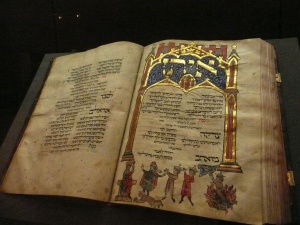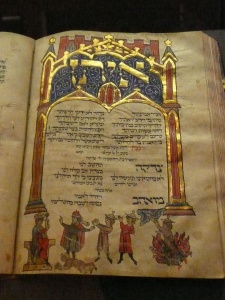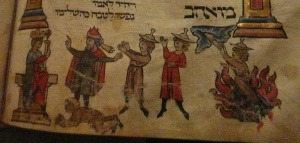Leipzig Machzor: A Vision from the Past
Seven hundred years ago in a synagogue in southwest Germany near the Rhine River, the chazzan opened a new machzor on Rosh Hashanah as he began Kol Nidrei. The congregation glanced up and gasped as they saw the new prayer book he was davening from.
A freshly written large-scale parchment book presented itself to them, specially made for the bimah for all the holidays, resplendent with brightly colored illuminations and richly adorned with gold-leaf and precious lapis lazuli decorations.

Thus what we know as the Leipzig Machzor, currently on view at the Grolier Club until November 21, began its congregational life, filling whoever saw it with wonder, awe and a touch of puzzlement as to how such a beautiful object could be part of Jewish ritual life. This illuminated manuscript, considered “the most sumptuous of the south German illuminated machzorim …[that] has the most extensive array of text illustrations” (Bezalel Narkiss) is one of a handful of such manuscripts that have survived from the years between 1258 and 1340, all written in southern Germany, most illuminated in a distinctive style that borrows from Christian manuscripts of the same era and distinguished by a peculiar kind of depiction of the human figures found therein.
We know from a hidden signature in one of the decorated text panels that the first volume was written by the same scribe, Menachem, who created the Bird’s Head Haggadah about the same time. That haggadah is distinguished by illuminations in which all the human figures have bird heads instead of human faces. They wear the same medieval costumes and distinctive “Jew hats” as our Machzor. Its just that they aren’t fully human.
The Leipzig Machzor employs a similar kind of human distortion; all of the heads seem to have normal faces, always in profile, except that they have large beaks instead of noses. Similarly their mouths have been replaced by the downward curve of the bird-like beak. They look fully human until you look more closely.
A later manuscript, the Tripartate Machsor from 1320 also features figurative illuminations except here all the male figures have normal human faces whereas the women are depicted with animal heads. What are we to make of these distortions?
While it is tempting to simply attribute such distortions to a pious fear of violating the Second Commandment, the inconsistencies between manuscripts are puzzling. Scholarly opinion is much vexed over this issue, especially considering that the dominant rabbinic authority of the time and region, Rabbi Meir of Rothenburg (d. 1293) ruled that figurative illuminations in prayer books “did not violate the biblical injunction against idolatrous images.” Nonetheless “he raised the issue of their distracting the worshiper during prayer.” Even so he permitted these images in prayer books (Jewish Texts on the Visual Arts by Vivian B. Mann, pg.106). If distraction was the issue, wouldn’t human figures looking like animals be even more disturbing, especially in a machzor that could be easily seen by much of the assembled congregation? A comprehensive answer may never be fully resolved since, as scholar Marc Michael Epstein has commented, “each manuscript represents a particular constellation of patrons, artist and [local] rabbinic advisors” almost all of whom are absent from the historical record.

In the exhibition the Leipzig Machzor is open to the beginning of the chazzan’s repetition of Mincha for Yom Kippur. The text is contained within an elaborate medieval gate, topped by crenellated battlements, flanked by pointed towers. The gold leaf glistens and surrounds the initial word, Eitan, also written in gold leaf set off by a deep blue background ornamented with delicate floral tracery. Beneath the double arches the remainder of the piyut is inscribed in square Ashkenazi script, describing how Abraham (Eitan) recognized the One God when all else were blinded by idolatry. This is the exact same piyut we say today, seven hundred years later. Some of the standard prayers are abbreviated such as the communal response “Remember us for life,” the brocha “Blessed are You, Hashem, Shield of Abraham” and “You are eternally mighty…” At the bottom of this page the piyut continues “The beloved (m’ahav) only son [Isaac] of his mother, [gave up] his soul wholeheartedly to the slaughter.’ Arranged along the very bottom of the page is a scene containing six figures depicting a conflated narrative from the Midrash Rabbah (38:13) and other midrashic sources.

On the extreme left Nimrod is seated on a throne, wearing a crown and holding a staff. He gestures upwards asserting his authority, demanding that Abraham worship fire. Before him is the bearded figure of Terah in a turban, evidently explaining the wayward behavior of his son Abraham in destroying his idols. At his feet is a servant pleading with the king to rescind his death sentence of Abraham. Next are two clean-shaven figures in Jew’s hats, Abraham and his brother Haran. Abraham is more assertive, thrusting both hands forward while Haran equivocates, one hand up the other down. Finally on the right edge we see Abraham again, now engulfed in flames while heavenly hands save him from the fiery furnace.
This illumination dramatically depicts Abraham’s blind faith in the One God, a faith he alone possessed. By many accounts this was one of Abraham’s 10 tests. He was ready to renounce his father, the powerful king Nimrod and brave the flames of death in testament to the reality of God. The pictorial scheme of this page forcefully links the title word, Eitan meaning mighty, with Tz’dakah meaning righteousness, and M’ahav, beloved, with a midrashic image that transcends the simple text to create a deeper and more complex meaning, a visual piyut on the textual piyut itself.
As the chazzan (and his congregation peering over his shoulders) gazed at this page such an interpretation must have dawned on them. What an insight and inspiration to have as the awesome Day of Atonement is slowly slipping by, presenting us with the enormous challenge of now continuing our lives, forgiven surely, but still needing the strength to continue our teshuvah, overcome our tests of faith and struggle with sin that will certainly tempt us.
Seven hundred years after it was created the Leipzig Machzor still inspires us to strengthen our faith by Abraham’s example. Perhaps no less so this medieval manuscript will inspire us to create new works of art in image and text, even illuminated machzorim, that pay homage and even challenge the achievements of our forefathers so long ago.
Pursuit of Knowledge: 600 Years of Leipzig University
Grolier Club
47 East 60th Street, New York